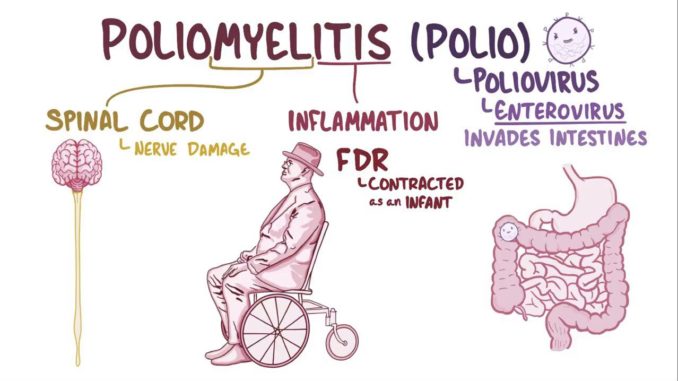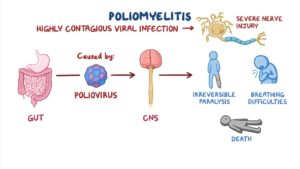
Table of Contents
What is Poliomyelitis?
- The name poliomyelitis stems from the Greek word “polio” meaning “grey” and “myelon” meaning “marrow.”
- Poliomyelitis is an infectious disease brought on by the poliovirus, a member of the Picornaviridae family of the genus Enterovirus.
- Poliomyelitis, often shortened to polio, is an extremely contagious viral disease which attacks the nerve system and can cause irreversible paralysis.
- It is spread by lymphatic replication and fecal-oral contamination.
Key Facts
- Poliomyelitis primarily affects children under the age of 5, although it can affect older children and adults,
- An infection causes permanent paralysis 1 in 200 times among which 5-10% of persons who are paralyzed pass away due to respiratory muscles are paralysis.
- Polio was one of the most dreadful diseases in the world before the polio vaccine was developed in the 1950s.
- From an estimated 350 000 cases in 1988 to 6 documented cases in 2021, cases of wild poliovirus have reduced by approximately 99%.
- The majority of nations have eradicated polio as a result of massive vaccination campaigns; just a small number of endemic nations remain, including Afghanistan and Pakistan.
- Nonetheless, occasional outbreaks of the disease have occurred in other parts of the world, and regions with poor vaccination rates where the danger of seeing it return also exist
- The disease is most common in parts of the world with poor sanitation and limited access to safe drinking water, as the virus is spread through contaminated fecal matter and can survive in water and sewage for weeks
- It is anticipated that polio would be completely eliminated in the near future with sustained vaccination campaigns and public health initiatives.
Causes of Poliomyelitis
- Polio virus is responsible for causing polio, which primarily affects nerve cells in the spinal cord and brain stem that are responsible for muscle movement.
- There are three types of poliovirus: wild poliovirus type 1, 2, and 3.
- WPV2 and WPV3 have been completely eliminated, and WPV1 is only found in some regions of the world. WPV1 is the most likely type to lead to paralysis.
- The vaccine-derived poliovirus (VDPV) is another variation of the virus that is more common and currently accounts for most polio infections globally.
Types of Polio and Their Symptoms
Spinal polio
- This is the most common type of polio, which affects the spinal cord and can cause paralysis.
- Symptoms include fever, fatigue, headache, stiffness in the neck, and muscle pain.
Bulbar polio
- This type of polio affects the brainstem, which controls breathing and swallowing.
- Symptoms include difficulty breathing, speaking, and swallowing, as well as weakness in the facial muscles.
Bulbospinal polio
- This is a combination of spinal and bulbar polio, affecting both the spinal cord and brainstem.
- Symptoms include paralysis, difficulty breathing, speaking, and swallowing, as well as muscle pain and stiffness.
Stages of Poliomyelitis/Polio
Initial/acute stage
- The acute stage is mostly characterized by symptoms including fever, stiff neck, severe muscle weakness, paraparesis, and autonomic dysfunction.
- This phase lasts between one and two weeks.
- The virus multiplies at this stage in the intestines and throat.
Paralytic stage
- The virus may occasionally reach the neural system and damage the brainstem and spinal cord.
- Other neurological symptoms, such as paralysis and muscular weakness, may result from this.
- One or more limbs may be paralyzed temporarily or permanently, or the entire body may be affected.
Recovery stage
- If the patient survives the acute phase of the illness, they may begin to recover gradually.
- The acute symptoms vanish during the convalescent or recovery period, and the healing of paralyzed muscles starts.
- This stage can last up to two years.
- The patient is left with residual paralysis, an imbalance in muscular power, and bad posture; to restore their strength and mobility, they may need physical therapy or rehabilitation.
Muscles Affected by Poliomyelitis/Polio
- Poliomyelitis/polio can affect any muscle, although it most frequently affects the muscles in the legs, hips, and back.
- It can also impair the muscles that control breathing and swallowing.
- All muscles, including those in the arms, may be damaged in extreme situations.
- Depending on the degree of muscle weakness or paralysis, some people may fully recover while others may have a lifetime disabilities.

Risk Factors
Not getting vaccinated
- Vaccination is the most effective method of poliomyelitis prevention.
- The likelihood of getting the virus increases if you don’t get vaccinated.
Travelling to endemic areas
- Some regions of the world, particularly those with poor hygienic conditions, still have poliomyelitis.
- Travelers to these regions run the risk of contracting an infection.
Weak immune system
- The virus is more easily contracted by those whose immune systems are compromised, such as individuals who have HIV/AIDS or are receiving chemotherapy.
Age
- Children under the age of five are most susceptible to contracting polio.
Living in crowded areas
- The risk of spreading the virus rises when people live in crowded areas like slums or refugee camps.
Poor hygiene and sanitation
- Food, water, or feces can all be contaminated and carry the polio virus.
- The risk of the virus spreading is increased by poor WASH (water, sanitation and hygiene).
Transmission
- Poliomyelitis is transmitted by contact with contaminated feces through fecal-oral route
Diagnosis of Poliomyelitis
- Poliovirus can be isolated in cell culture or detected using polymerase chain reaction in specimens from the throat, feces (stool), and occasionally cerebrospinal fluid (CSF). (PCR).
- Laboratories test for poliovirus includes:
- Culture
- Intratypic variation
- Genome analysis
- Serology
Complications
- Mild to severe muscular weakness and paralysis are the most frequent polio complications.
- The muscles involved in breathing and swallowing can be affected by polio.
- Many years after the initial infection, polio may lead to a condition known as post-polio syndrome, which can result in muscle weakness, exhaustion, and discomfort.
- Polio can induce muscle weakness and paralysis, which can result in abnormalities like scoliosis or foot drop.
- Increased risk of contracting other infections
- Psychological and emotional repercussions of polio can occur, especially in those who have been left with lifelong disability
Prevention and Treatment
Vaccination
- Getting vaccinated is the best approach to avoid contracting poliomyelitis.
- All children should receive the polio vaccine as part of their regular immunization schedule because it is both safe and effective.
Good hygiene
- Maintaining good hygiene, such as regularly and thoroughly washing your hands, will help stop the virus from spreading.
Isolation
- To stop the virus from spreading, people with poliomyelitis should be kept apart from other people.
Supportive care
- Poliomyelitis treatment entails supportive care to control symptoms and side effects like breathing, swallowing, and muscle weakness.
Physical therapy
- Physical therapy can help people regain strength and mobility who have lost it due to paralysis or muscle weakness.
Surgery
- To rectify abnormalities or enhance function in serious cases, surgery may be necessary.
Management of post-polio syndrome
- Pain relief, physical therapy, and lifestyle changes may be helpful for those who have the condition.
WHO Response
- WHO provides global leadership and coordination for polio eradication efforts, working closely with partner organizations, governments, and other stakeholders.
- WHO supports national immunization campaigns to deliver polio vaccines to children, particularly in areas with low vaccination coverage or in populations with weak immune systems.
- WHO supports disease surveillance activities to detect polio cases and outbreaks, and provides technical support to countries to respond quickly to contain outbreaks and prevent further spread of the disease.
- WHO supports research and innovation to improve polio vaccine effectiveness and safety, and to develop new tools and strategies for disease surveillance and outbreak response.
- WHO engages in advocacy and communication activities to raise awareness about the importance of polio eradication, and to mobilize political and financial support for the effort.
References and For More Information
https://www.who.int/news-room/fact-sheets/detail/poliomyelitis
https://my.clevelandclinic.org/health/diseases/15655-polio
https://www.sciencedirect.com/topics/medicine-and-dentistry/poliomyelitis
https://pubmed.ncbi.nlm.nih.gov/1879904/
https://www.ncbi.nlm.nih.gov/pmc/articles/PMC4212416/
https://www.mayoclinic.org/diseases-conditions/polio/symptoms-causes/syc-20376512
https://www.physio-pedia.com/Poliomyelitis